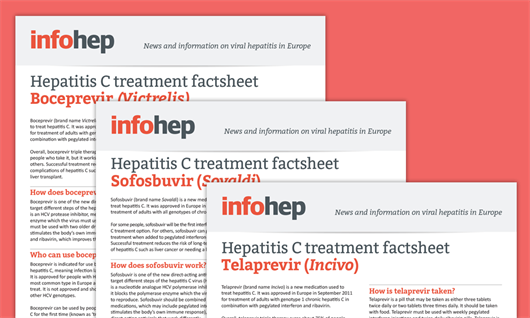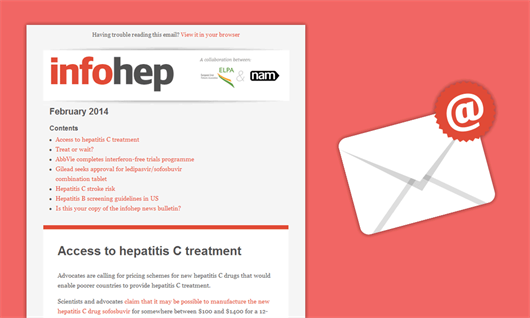Research on hepatitis C treatment presented at the International Liver
Congress reported very encouraging results across a range of populations.
The most important advances were the very high cure rates achieved by a number
of interferon-free regimens across multiple HCV genotypes, and the very good
results achieved in populations previously considered hard to treat. It is now
clear that hepatitis C will be curable with 12 weeks of treatment for the vast
majority of patients when new drug combinations become available in 2015.
Studies of combinations still in earlier stages of development may allow
hepatitis C to be cured after 8 weeks of treatment.
Previously untreated patients

Nezam Afdahl of Deaconess Medical Center, Boston, presents results of ION-2. Photo by Liz Highleyman, hivandhepatitis.com.
In people with hepatitis C genotype 1 infection, the new
fixed-dose combination of sofosbuvir and ledipasvir cured 99% of previously
untreated patients in the ION-1 study,
without ribavirin, after 12 weeks of treatment. The SAPPHIRE-1 study of a
three-drug combination developed by AbbVie, plus ribavirin, cured 95-98% of
previously untreated patients with genotype 1 infection after 12 weeks of
treatment. (Study results were published in the New
England Journal of Medicine during the congress.)
A two-drug
combination developed by Bristol-Myers Squibb cured 90% of people with
genotype 1b infection after 24 weeks of treatment.
A combination of two drugs developed by AbbVie cured
100% of previously untreated patients with genotype 4 infection when used
with ribavirin, after 12 weeks of treatment.
Previous non-responders and relapsers

Professor Stefan Zeuzem speaking at the International Liver Congress 2014. Photo by Liz Highleyman, hivandhepatitis.com.
Outcomes were equally impressive in previous non-responders
and previous relapsers. (‘Non-responders’ is the term used to descibe people whose viral load did not
decline sufficiently sharply when taking treatment previously and ‘previous
relapsers’ for people whose virus was brought below the limit of detection by
the previous therapy, but a relapse occurred after treatment ended and the
virus can be detected again.) The
AbbVie three-drug regimen cured 96% of treatment-experienced people with genotype
1 after 12 weeks of treatment, when used with ribavirin.
The co-formulation
of sofosbuvir and ledipasvir successfully treated a variety of difficult-to-treat
patient populations including people with genotype 3, people with
decompensated cirrhosis and people who were not cured with previous
sofosbuvir-containing therapy. In people with genotype 3 and in people with
prior experience of sofosbuvir treatment, 100% cure rates were reported. In
people who failed to respond to previous interferon-based treatment,
between 94 and 99% of patients were cured after 12 or 24 weeks of
sofosbuvir/ledipasvir treatment.
Simeprevir
combined with pegylated interferon and ribavirin cured 88% of European patients
with genotype 1 infection after a total of 24 weeks of treatment in the
phase III PROMISE study. European people with genotype 1a infection are much
less likely to have the Q80K variant of genotype 1a which reduces the efficacy
of simeprevir.
People with cirrhosis

Professor Fred Poordad, of the Texas Liver Institute at the University of Texas, speaking at the International Liver Congress 2014. Photo by Liz Highleyman, hivandhepatitis.com.
Treatment responses were also highly encouraging for people with
cirrhosis
of the liver. Sofosbuvir
and ribavirin achieved end-of-treatment virological response rates in 93%
and 100% of patients with class B (advanced) and class A (well-compensated)
cirrhosis respectively (using the Child-Pugh system of assessing the severity
of liver cirrhosis).
AbbVie
reported that the largest study of new direct-acting antivirals yet
conducted in people with hepatitis C genotype 1 who have compensated cirrhosis showed
that it is possible to cure between 92 and 96% of people with cirrhosis,
regardless of previous treatment history, within 12 to 24 weeks.
Liver transplant patients

Xavier Forns speaking at the International Liver Congress 2014. Photo by Liz Highleyman, hivandhepatitis.com.
New direct-acting antiviral combinations also protect
against the recurrence of hepatitis C in a high proportion of liver transplant
patients. When combined with ribavirin, AbbVie’s
three-drug combination cured 96% of liver transplant patients with genotype
1 infection. A
study of patients with more advanced post-transplant liver damage due to HCV
recurrence found that 64% were cured after 24 to 48 weeks of treatment with
sofosbuvir and ribavirin. This study reported on patients who received
sofosbuvir on compassionate release in Spain.
HIV co-infection

Anu Osinusi, from the US National Institute of Allergy and Infectious Diseases, speaking at the International Liver Congress 2014. Photo by Liz Highleyman, hivandhepatitis.com.
New EASL guidelines state there is no reason to treat people
with HIV and HCV co-infection for longer, or with different drugs, than the
rest of the population with HCV. Results of a pilot study of
sofosbuvir/ledipasvir in people with HIV and HCV genotype 1 co-infection pointed
to the possibility of universal cure of hepatitis C in this population. An
interim analysis of the ERADICATE study showed that all patients with
co-infection with 12 weeks of post-treatment follow-up were cured of hepatitis
C.















Connect with infohep on Facebook: Keep up to date with all the latest news and developments.
Follow infohep on Twitter for links to news stories and updates from infohep.org. Follow us at www.twitter.com/infohep.
Follow all the infohep news by subscribing to our RSS feeds.